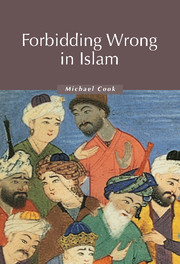Book contents
- Frontmatter
- Contents
- Preface
- Map
- 1 Introduction
- 2 The elements of the duty of forbidding wrong
- 3 How is wrong to be forbidden?
- 4 When is one unable to forbid wrong?
- 5 What about privacy?
- 6 The state as an agent of forbidding wrong
- 7 The state as an agent of wrongdoing
- 8 Is anyone against forbidding wrong?
- 9 What was forbidding wrong like in practice?
- 10 What has changed for the Sunnīs in modern times?
- 11 What has changed for the Imāmīs in modern times?
- 12 Do non-Islamic cultures have similar values?
- 13 Do we have a similar value?
- Index
3 - How is wrong to be forbidden?
Published online by Cambridge University Press: 05 June 2012
- Frontmatter
- Contents
- Preface
- Map
- 1 Introduction
- 2 The elements of the duty of forbidding wrong
- 3 How is wrong to be forbidden?
- 4 When is one unable to forbid wrong?
- 5 What about privacy?
- 6 The state as an agent of forbidding wrong
- 7 The state as an agent of wrongdoing
- 8 Is anyone against forbidding wrong?
- 9 What was forbidding wrong like in practice?
- 10 What has changed for the Sunnīs in modern times?
- 11 What has changed for the Imāmīs in modern times?
- 12 Do non-Islamic cultures have similar values?
- 13 Do we have a similar value?
- Index
Summary
By now we are sufficiently familiar with Muslim scholasticism not to expect simple answers to apparently simple questions. So when we ask how one is to forbid wrong, we can be sure that there will be no one way of doing it. In fact we have already met a key Prophetic tradition according to which there are three modes of forbidding wrong: with the hand, with the tongue and in the heart – or, as some understand the usage, with the heart. This threefold division is a useful one. It is widely known, and frequently used by the scholars as a basic building block for their doctrines. Yet it has its limits.
For one thing, the schema was not employed by everyone. The Sunnīs, Ibāḍīs and Imāmīs made extensive use of it. But the Muʿtazilites rarely did so, and the Zaydīs only resorted to it in later centuries under Sunnī influence. More surprisingly, Ghazzālī seems to have had no interest in it, though he must have been well acquainted with it (indeed he quotes the tradition together with its frame-story). The schema is also a bit crude for many purposes. It does not, for example, distinguish between a delicate hint and a ruthless tongue-lashing, or between a restraining hand and recourse to arms. Finally, there is something rather peculiar about the sequence. The tradition tells you to right a wrong with your hand, and failing that with your tongue, and failing that in your heart.
- Type
- Chapter
- Information
- Forbidding Wrong in IslamAn Introduction, pp. 27 - 44Publisher: Cambridge University PressPrint publication year: 2003
- 1
- Cited by

